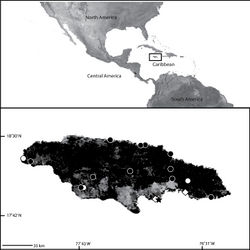Selenops petrunkevitchi
| Notice: | This page is derived from the original publication listed below, whose author(s) should always be credited. Further contributors may edit and improve the content of this page and, consequently, need to be credited as well (see page history). Any assessment of factual correctness requires a careful review of the original article as well as of subsequent contributions.
If you are uncertain whether your planned contribution is correct or not, we suggest that you use the associated discussion page instead of editing the page directly. This page should be cited as follows (rationale):
Citation formats to copy and paste
BibTeX: @article{Crews2011ZooKeys105, RIS/ Endnote: TY - JOUR Wikipedia/ Citizendium: <ref name="Crews2011ZooKeys105">{{Citation See also the citation download page at the journal. |
Ordo: Araneae
Familia: Selenopidae
Genus: Selenops
Name
Selenops petrunkevitchi Alayón-García, 2003 – Wikispecies link – Pensoft Profile
- Selenops petrunkevitchi Alayón-García 2003[1]: 120, Figs 7–8 (♀, not examined).
Note
The female holotype of Selenops petrunkevitchi Alayón-Garcíais stated to be deposited in the PM (Alayón-García 2003[1]), but the specimen cannot be located at PM. Nevertheless, the description and illustrations are adequate to recognize the specimens described and listed below as this species.
Type material
Female holotype: Malvern, Santa Cruz Mountains, St. Elizabeth Parish, Jamaica (PM), not examined.
Material examined
JAMAICA: St. Thomas Parish: Blue Mountains National Park, Whitfield Hall, 18°02'54.8"N, 76°37'03.7"W, 1.VI.2006, ~1250 m, S. Chai, I. Wilmot, S. Crews, near cloud forest, under bark of eucalypts, SCC06_029 4♀, 7 imm. (IJNHM sel_365-368, EME sel_370-373, CAS sel_369, 374-375).
Diagnosis
While similar to Selenops wilmotorum sp. n., the shape of the anterior margin of the lateral lobes is more angular, and less sinuous, and the internal ducts are distinctly coiled (Figs 101–102). Males unknown.
Description
Female (sel_368 IJNHM): Color:carapace red-brown, dusky medially and laterally; sternum orange-brown, darker around border; chelicerae red-brown with black y-shaped marks beginning medially; maxillae light orange-brown lightening distally; labium brown, lightening distally; abdomen dorsally cream-colored with lanceolate stripe, pointed festoon, other dusky mottling around stripe; ventrally cream-colored, dark laterally and caudally; legs light orange-brown, annulations present, mottling on anterolateral faces of femora. Carapace: 0.82 times longer than broad; fovea longitudinal, broad, very shallow. Eyes:AER nearly straight; PER slightly recurved; PME larger than AME, PLE largest, ALE smallest; eye diameters, AME 0.23, ALE 0.08, PME 0.25, PLE 0.33; interdistances AME-PME 0.08, PME-ALE 0.18, ALE-PLE 0.28. PME-PME 1.28. ALE-ALE 2.15; ocular quadrangle AME-AME 0.50, PLE-PLE 2.18; clypeus 0.05 high. Mouthparts:chelicerae with a few stout setae medially and anteriorly; maxillae longer than broad, with tuft of conspicuous setae distally; labium distally rounded. Sternum: 1.11 times longer than broad, posteriorly indented. Legs:leg I only slightly shorter than II and III; leg formula 3214 or 2413 (Alayón-García 2003[1]); scopulae present on all 4 tarsi, metatarsi and tibiae I and II; tarsI I-IV with strong claw tufts; prolateral claw per foot slightly toothed; spination: leg I, Fm pr 0–0–1, d 1–1–1, rl 1–0–0; Ti d 0, v 2–2–2; Mt v 2–2; leg II, Fm pr 1–0–0, d 1–1–1, rl 0–0–1; Ti v 2–2–2; Mt v 2–2; leg III, Fm pr 1–0–0, d 1–1–1, rl, 0–0–1; Ti v 2–2–0; Mt v 2–2; leg IV, Fm pr 1–0–0, d 1–1–1, rl 0–0–1; Ti v 1–1; Mt v 2–1. Abdomen:with terminal setal tufts. Pedipalp:claw with 3 teeth, though looks like one or 2 teeth may have broken off. Epigyne:lateral lobes meet medially, extend anteriorly about half of the length of epigynal plate, angular along anterior margins, genital openings located just behind, epigynal pockets present; internally ducts coiled anteriorly to posteriorly, directed laterally, fertilization ducts located posteriorly,directed laterally, posterodorsal fold present, covering nearly ¼ of internal ducts (Figs 101–102). Dimensions: Total length 11.35. Carapace length 3.95, width 4.80. Sternum length 2.50, width 2.25. Abdomen length 7.40, width 5.10. Pedipalp: Fm 1.25, Pt 0.60, Ti 0.75, Ta 1.40, total 4.00. Leg I: Fm 5.00, Pt 1.90, Ti 4.60, Mt 3.75, Ta 1.60, total 16.85. Leg II: Fm 6.25, Pt 1.50, Ti 4.00, Mt 4.00, Ta 1.50, total 17.25. Leg III: Fm 6.70, Pt 1.90, Ti 5.00, Mt 4.00, Ta 1.50, total 19.10. Leg IV: Fm 5.60, Pt 1.65, Ti 4.00, Mt 3.75, Ta 1.50, total 16.50.
Natural history
Collected under bark, including eucalypts, at both low and high elevations (Fig. 187).
Distribution
Endemic to Jamaica, and appears to be widespread there (Map 11).
Taxon Treatment
- Crews, S; 2011: A revision of the spider genus Selenops Latreille, 1819 (Arachnida, Araneae, Selenopidae) in North America, Central America and the Caribbean ZooKeys, 105: 1-182. doi
Other References
- ↑ 1.0 1.1 1.2 Alayón-García G (2003) La familia Selenopidae (Arachnida: Araneae) en Jamaica. Revista Ibérica Aracnología 8:117-122.
Images
|


